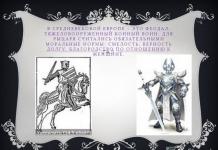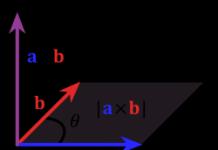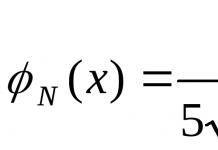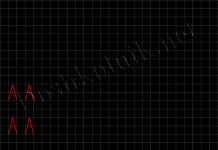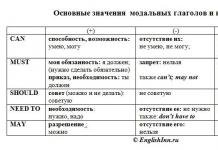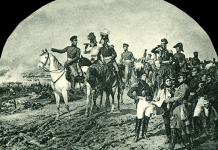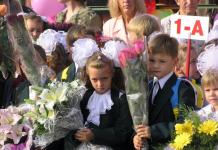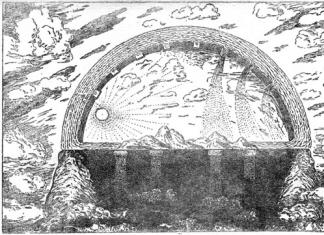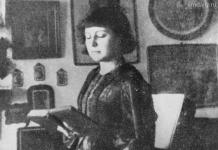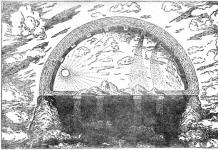For the 100th anniversary of the Revolution, the State Historical Museum organized an exhibition of drawings made in the first post-revolutionary year by students of two Moscow educational institutions: real school I.I. Alexandrov and the men's gymnasium named after M.V. Lomonosov.
Vasily Voronov, a scientist, teacher, and teacher of graphic arts, began collecting drawings and short children's texts about the events of those days in February 1917. In 1919, he transferred the collection to the State Historical Museum.
Evgeny Lukyanov, curator of the exhibition, art critic, senior researcher at the State Historical Museum:
Obviously, another drawing is dedicated to the same event.
As Evgeny Lukyanov said in an interview with Radio Liberty, the drawings from Vasily Voronov’s collection were made by boys: the collector taught drawing and calligraphy in gymnasiums for boys. The age of the authors is from 7 to 14 years.
“The Russian people did not like Tsar Nicholas II and decided to remove him. The king fulfilled the desire of the people and abdicated the throne. Having received freedom, the people began to rob and kill each other,” this is one of the texts from Voronov’s collection.
Many drawings are dedicated to rallies and demonstrations. It is especially interesting to read the slogans that the boys wrote on the banners - many of them are still relevant today.
But the places depicted in the pictures have changed after so many years.
According to historians, in children's drawings and texts preserved in Voronov's manuscripts, the difference in the perception of the two revolutions of 1917 - the February and October - is very clearly visible. “One revolution is a revolution that freed the country from tyranny, and the second is a bloody coup that plunged the country into tyranny,” notes Evgeniy Lukyanov.
30 years ago, in 1987, on the occasion of the 70th anniversary of the October Revolution, a unique pocket-sized book entitled “Moscow. 1917 Drawings of children who witnessed the events.” The publication published an unparalleled, fantastically interesting collection of drawings by children - little Muscovites, who, by the will of fate, found themselves witnessing revolutionary events 1917.
Descriptions of children's works are given from the list of illustrations at the end of the book. Additional descriptions - from the text by N.N. Goncharova, - in quotes. It must be said that the ideology of the Soviet era left a deep imprint on the art historical study of children's works. Some descriptions may cause amazement in the modern reader, others - a sarcastic smile. It should be remembered that the book was published at the beginning of the active phase of Gorbachev’s reforms...
The publication presents a collection of drawings in the form of a dramatic narrative, and begins with “images of the era”, or a series of “typical portraits”, referring to the famous series of photographs “Russian Types”, which we present in our today’s publication...
Images of the revolutionary era

1. THE GREAT BOLSHEVIK PARTY. 1917

2. DOWN WITH WAR, GIVE US BREAD. 1917
Author Ivan Kashtanov Paper, graphite and colored pencils. 33.2X24.0 cm. Author's signature at the top: left - Ivan, right - Kashtanov. Inscriptions: on the banner - Down with the war, give us bread; on the right in the frame - a Bolshevik is a person who goes to war and asks for a lot of bread.
30 years ago, in 1987, on the occasion of the 70th anniversary of the October Revolution, a unique pocket-sized book entitled “Moscow. 1917 Drawings of children who witnessed the events.” The publication published an unparalleled, fantastically interesting collection of drawings by children - little Muscovites who, by the will of fate, found themselves witnessing the revolutionary events of 1917.
Descriptions of children's works are given from the list of illustrations at the end of the book. Additional descriptions - from the text by N.N. Goncharova, - in quotes. It must be said that the ideology of the Soviet era left a deep imprint on the art historical study of children's works. Some descriptions may cause amazement in the modern reader, others - a sarcastic smile. It should be remembered that the book was published at the beginning of the active phase of Gorbachev’s reforms...
The publication presents a collection of drawings in the form of a dramatic narrative, and begins with “images of the era”, or a series of “typical portraits”, referring to the famous series of photographs “Russian Types”, which we present in our today’s publication...
Images of the revolutionary era

1. THE GREAT BOLSHEVIK PARTY. 1917

2 . DOWN WITH WAR, GIVE US BREAD. 1917
Author Ivan Kashtanov Paper, graphite and colored pencils. 33.2X24.0 cm. Author's signature at the top: left - Ivan, right - Kashtanov. Inscriptions: on the banner - Down with the war, give us bread; on the right in the frame - the Bolshevik is the person who walks P(r)ti (v) war and asks for a lot of bread.

Unknown author Paper, pencil, watercolor. 34.7X 26.5 cm. Inscriptions: Down with the war and the bourgeoisie; below - Bolshevik. A Bolshevik is someone who is against war; on the back (by the hand of V. S. Voronov) - Drawing of 12 years.

r child.

4. BOLSHEVIK. 1917
5. JUNKER AND BOLSHEVIK. November 1917 Juncker [ Juncker- students of military schools that trained officers.

6 . During the Great October Socialist Revolution in Moscow and St. Petersburg, the main military forces of the counter-revolution]; on the right is the Bolshevik.

SAILOR-BOLSHEVIK. 1917
7. BOLSHEVIK SAILOR FROM THE CRUISER “AURORA”. 1917 "...Big endowed with the image of a Bolshevik sailor from the cruiser Aurora. Its author thinks unconventionally. The image is close to the viewer, enlarged to the size of half life and built on the principle of a shoulder portrait, which is unusual for children's drawing. Children, as a rule, tend to strive to capture the entire image, complete it and express it through details. The drawing is also striking in color - it is designed in only multifaceted ocher tones. There are no banners or proclamations here, but the image has a truly hypnotic power. This impression is achieved by the entire set of artistic means - composition, color, bold decorativeness, rhythmic repetition of lines in facial features."

8. PROLETARIAN. 1917

9. MASHA THE BOLSHEVICH. 1917
“...The image of Masha the Bolshevik, a girl from the people, who for the first time in history becomes a true mistress of life, is extremely attractive with her healthy, fresh beauty, strength, and confidence. Her pose says the same thing. This impression is enhanced by the bright major combination of blue and red and the clean, bold outline. The carefully drawn style of the dress and jewelry makes her look extremely modern. At the same time, it should be noted that the author’s special decorative gift is manifested not only in color, but also in the patterning, ornamental nature of the silhouette, in symmetry, staticity, making one recall the folk clay toy - the whistle" [p. 21].

10 . RED GUARDSMAN WITH BANNER. 1917
Unknown author. Paper, watercolor, pencil. 34.5X26.4 cm. Inscriptions: on the banner - Long live Germany). Long live the world. Hooray); below - a Red Guard [Red Guard - voluntary armed detachments of workers organized to defend the revolution. Existed from April 1917 to March 1918; were disbanded due to the formation of the Red Army]; on paper in hand—vote for No. 5 [“Vote for No. 5”—an electoral call to vote for the list of Bolshevik candidates (list No. 5) in the elections to the Moscow city and district dumas].
“...Figure 10 carries a large informative load. The slogans on the banner of the Red Guard hero were taken to their logical conclusion - not only “Long live peace!”, but also “Long live Germany!” It would not be surprising if the drawing dated back to the time of the revolution in Germany. But no, the electoral appeal “Vote for List No. 5” in the hands of a Red Guard speaks of the time of elections to the city or district Moscow Duma. This means that the drawing dates from June or September 1917. There is a war with Germany, it is the enemy, nevertheless the Bolsheviks boldly put forward an international slogan. The people understood him, accepted him, and even to a child the slogan “Long live Germany!” didn’t seem treacherous” [p. 22].

11 . RED GUARDS-BOLSHEVIK. 1917

12 . SR-AGITATOR. 1918
Unknown author. Paper, gouache, watercolor, pencil. 34.7X25.5 cm. Inscriptions: below - They want to have the old government against the new government; at the top of the flag - S.R. [Socialist Revolutionaries - members of the Socialist Revolutionary Party, continuers of the populist traditions in the Russian revolutionary movement].

13. CADET WITH A CANE. 1917
Unknown author Paper, watercolor, pencil. 24.3X12.3 cm. Inscription below: cadet. [The Cadets are members of the constitutional democratic party (party of “people’s freedom”). They were declared enemies of the people immediately after the October Revolution].

“...in another drawing the Bolshevik is represented as a monster with wide, evil eyes, shooting from a pistol. This drawing would not have stopped our attention if not for the inscription. In its first part, as in many other works, the Bolshevik program is set out - “goes against the war and the government” (maybe these are the words of the teacher?), but the second part of the inscription - “and wants to betray Russia” (!) - is undoubtedly expresses his own opinion, or more precisely, his family’s, his environment’s. These words were added by the same child's hand, but small, hastily, with a different pencil, obviously not at the same time as the first part. Likewise, the face of a Bolshevik (by the way, in terms of clothes, he can least of all relate to the Bolsheviks, since he is wearing a uniform Cossack troops) rubbed and rubbed with an elastic band to give it especially “brutal” features. One might think that the boy associated atrocity, as such, with the Cossacks, with the dispersal of demonstrations, that is, with what the child saw himself and knew about from adults. I heard from adults that a Bolshevik is “a traitor and a villain,” and I combined both figures—the Cossack and the Bolshevik” [p. 23-24].

15. BOLSHEVIKS AND FREE RUSSIA. July - October 1917
Author A. Konstantinov. Paper, watercolor, pencil. 34.1X23.9 cm. Bottom right signature and date: A. Konstantinov. 1917 Inscriptions: below - Bolshevik. Let us through there. Russia, no, I won’t let you go, you gentlemen are very good; on a woman's dress along the hem - Ros ci I; On the door behind Russia there is a sign with the inscription: Freedom. [Drawing made after the July 3rd demonstration].
“The penetration of the class contradictions of the era into the consciousness of children is also reflected in A. Konstantinov’s drawing, solved in an allegorical form. Russia is represented here in the image of a girl in Russian dress, behind her is the door to a “free” country (but the “freedom” that brought The February Revolution, in fact, is as ostentatious and operetta-like as this girl herself in a sundress and kokoshnik). She refuses to allow Bolsheviks, terrorists, and disruptors of public order, depicted with a smoking bomb in their hands, into the “free” country” [p. 24].

“...A boy named Nikitin made a drawing with the definite intention of ridiculing the idea, the bearer of which is a Red Guard. This is how we usually imagine the caricatured type of anarchist: hands in his pockets, a cigarette in his mouth, a defective upper part of the face due to the hypertrophied lower part. The cap is pulled down over the red nose, indicating a penchant for alcohol. There is a red bow on the neck, demonstrating the extreme left position of its owner. All components of the drawing actively work towards the assigned task. The silhouette is especially expressive - the head, clothes, the riding coattails of the jacket, the wavy line of lowered trousers. Confidently, firmly, with pressure the contour is defined, the coloring easily and evenly fills the form” [p. 23].

17. BURGEOUS WITH A CIGARETTE. 1917

18. BURGEOUY WITH A BOX OF CANDY. 1917
Unknown author. Paper, watercolor, pencil. 34.1X26.8 cm. Inscriptions below: on the right - bourgeois; on the left - bourgeois. On the candy box - T. S. Ciy and Co. Moscow [S. Ciy and Co. was a company that owned a confectionery factory (13 Petrogradskoye Shosse) and six confectionery stores in Moscow. On the basis of the Ciy factory, the Bolshevik confectionery factory was formed].
“...The main idea embodied in the image of a bourgeois with a box of chocolates is his complete worthlessness. This is a slacker, a dandy and a reveler. With amazing flair, the color solution for the design was found - the red-crimson tone of the tailcoat in combination with black (top hat, tailcoat lapels) and yellow (box, boutonniere, monocle). This color accord, bright but refined, in itself creates an idea incompatible with any labor activity. An idea fully expressed by color alone is reinforced by pose and attributes. In a helpless, graceful gesture, the idle hands holding a cane and candy are set aside. The result was a laconic, but completely complete satirical portrait of a creature parasitizing at the expense of the working part of society” [p. 25].

“...The speculator is frankly scary. His figure is ominous: a blue-gray coat and top hat, a blue mustache, beard and eyebrows, villainous eyes set askew on his yellow face. The child’s sharply negative attitude towards his character also determined the uniqueness of the image and its instantaneous discovery. The drawing of the hands - a circle lined with five lines (resulting, by the way, in not five, but six fingers), and the inscription, ornamentally included in large letters in the drawing, indicate a very young preschool age author" [p. 25-26].

20. BURGEOUYWITH THE NEWSPAPER “RUSSIAN WORD”. 1917
Unknown author Paper, watercolor, pencil. 26.5X15.3 cm. Inscription at the top: Burzhiy; on the newspaper - Russian O(e) word. [« Russian word"- a daily Moscow newspaper published by I. D. Sytin. Represented the interests of the liberal bourgeoisie. It was closed in January 1918].
“...Bourgeois with a newspaper - public figure, stockbroker, Octobrist. The main detail that characterizes it is the bourgeois newspaper “Russian Word”. The little artist, who couldn’t even cope with the word “bourgeois,” nevertheless very accurately finds an artistic solution for his hero. The expressive ratio of colors (yellow, purple, black), the sharply drawn outline of the silhouette, reminiscent of a large bird of prey, help reveal the essence of a self-confident “master” of life” [p. 25].
social - democratic parties to the Bolsheviks and Mensheviks].
“...The comparison of the Bolshevik and the Menshevik on one sheet of paper is significant. The Bolshevik is huge, the Menshevik in front of him is like a mushroom. What prompted the child to make such an interpretation? Yes, the fairy tale names themselves, the fairy tale characters themselves. The giant, the little boy - creatures familiar from early childhood, they are always nearby, they are close and familiar. But the author proves the difference between these people not only by size. The little one, although small, is dressed in an expensive fur coat, and the big one has all his pants in multi-colored patches, he is in a leather jacket, felt boots and is armed. This is a worker, a poor man, a revolutionary. And the little one is rich, he is not for the revolution. Thus, the social essence of relationships is not understood by the child as primitively as it might seem at first glance” [p. 26].

24. BOLSHEVIK LENIN AND MENSHEVIK DAN. July - October 1917
Unknown author/ Paper, graphite and colored pencils. 36.3X21.9 cm. Inscriptions: at the top of the banners - Down with the Bourgeois Government, you will find protection only with the Bolsheviks; at the bottom in the middle is the Bolshevik Lenin; on the appeal that Lenin holds in his hand, “Do not submit to the provisional government(s) of the traitor Kerensky.” Ask the Bolsheviks for peace with Germany. Arm yourself and go against the provisional government); under a long scroll in right hand Lenin is the appeal of a Bolshevik; on the right under the small figure - Dan Menshevik [Gurvich-Dan Fedor Ilyich (1871 - 1947) - one of the leaders of the Mensheviks. In 1922 he was expelled abroad.]; on the sheet in the Menshevik's hand - beat the Bolsheviks i on betray l(to her).
“The Bolshevik and the Menshevik are V.I. Lenin and F.I. Dan. A sharp political struggle is expressed in the opposition between the two leaders of the Social Democratic parties. The spiritual significance and moral strength of these people are conveyed through their size. Both images are accompanied by extensive text defining their political platforms. Lenin opposes the Provisional Government, in defense of the people. Dan's appeal reflects only the factional struggle against the Bolsheviks, contains abuse and a call to beat the Bolsheviks. Finally, although both of them are poorly dressed, there are still many more patches on Lenin’s clothes. History itself resolved their dispute very quickly. Lenin was and will remain the leader of the world proletariat, Dan has already been forgotten by his contemporaries” [p. 26-27].
When using the material, a reference to the publication is required:
Moscow. 1917 Drawings of children who witnessed the events. From the collection of the State Historical Museum. / Comp. and the author of the text N.N. Goncharova. –M., 1987.
Digitization:
Internet magazine “Moscow Region Local Historian”, 2017 When reposting, a link to trojza.blogspot.com is required.
Exhibition dedicated to the centenary of the Great Russian revolution, presents about 150 children's drawings created in 1917-1918. A unique collection of children's drawings arrived at the museum in 1919 from Vasily Sergeevich Voronov (1887–1940), a famous scientist and teacher who spent many years studying artistic creativity children.
Children's creativity was one of most important discoveries that the 20th century brought to the field of art. Large art critic Ya.A. Tugendhold noted that “already from late XIX centuries, children's drawings have ceased to be in the eyes of adults blots of pranks, scribbles of ignorance; They saw in them genuine creativity - disinterested, unconscious, in which the child lavishes his characteristic flowery fantasy and freshness of expression.
Thus elevated to the rank of “high art,” children’s creativity found its connoisseurs, collectors and researchers. Among them was V.S. Voronov, who was the first to see in children’s drawings not only an artistic object, but also an important historical source. With the outbreak of the First World War, realizing the epoch-making significance of what was happening, he began collecting drawings on a military theme, and then on a revolutionary one. In one of his articles, the scientist wrote: “The future historian of our days will be grateful for every truthful and true feature that reflects our modernity. In the future huge chronicle of our days there should be lines inscribed by the hand of children, and their drawings, directly reflecting what they saw and what they thought.”
The exhibited drawings were mainly performed by students of two educational institutions, where V.S. taught Voronov: real school I.I. Alexandrov and the men's gymnasium named after M.V. Lomonosov in Moscow. Their authors were boys aged 7 to 13 years, whose names, unfortunately, are almost unknown to us (most of the drawings are anonymous).
Some of the children's “revolutionary” drawings from the collection of V.S. Voronova was demonstrated in 1918 at small exhibitions at the gymnasium named after M.V. Lomonosov (January) and real school I.I. Alexandrova (March). This exhibition is the first large-scale display of a collection of children's “revolutionary” drawings from the collection of the Historical Museum within the walls of the Historical Museum itself.
The exhibition is divided into two main sections. The first section is devoted to “Images of the revolutionary era.” Here are presented numerous images of Bolsheviks and Mensheviks, Cadets and Socialist Revolutionaries, bourgeois and proletarians, Junkers and Red Guards. Many of the drawings are accompanied by inscriptions, also made by a child’s hand, explaining the political and social affiliation of a particular character.
The second section of the exhibition tells about the events of the revolutionary 1917 and post-revolutionary 1918. The drawings are divided chronologically into four themes: “February Revolution”, “Between February and October”, “October Revolution”, “After October”. The peculiarity of this group of drawings is that almost all of them were executed directly from life, based on real life observations that unfolded in abundance before the attentive eyes of children. In these drawings one can see demonstrations and rallies, lines for food and cars with revolutionary soldiers, battles on the streets of Moscow and shelling of the Kremlin, city decorations on the occasion of the first anniversary of the October Revolution and designs for the coat of arms of the young Soviet state.
In addition to drawings, the exhibition presents unique photographs, popular prints and posters made in 1917, which will help the modern viewer look at the events of a hundred years ago with “adult” eyes and compare this “experienced” view with the direct view of a child.
The exhibition is decorated with two series of postcards released in 1917: “Children-Politicians” (art. V.A. Taburin) and “Children-Demonstrators” (art. S. Kushchenko) (from the private collection of S.A. Chapkina-Ruga) , which find a number of parallels with children’s “typical” drawings.
The visuals of the exhibition are complemented by excerpts from children's writings of 1917 and quotes from unpublished articles by V.S. Voronova.
We continue to publish illustrations from the book “Moscow. 1917 Drawings of children who witnessed events” (Moscow, 1987). Children's drawings collected by V.S. Voronov have been kept in the State Historical Museum since 1919.
Having introduced readers to a series of “revolutionary types”, the author of the publication, candidate of art history N. N. Goncharova, publishes drawings by Muscovite children, reflecting plot scenes from the period between February and October revolutions 1917.
Between two revolutions
25. DEMONSTRATION NEAR THE BIG THEATER. August 1917
Unknown author. Paper, watercolor, pencil. 26.4X16.9 cm. Inscriptions on the posters: Long live the democratic republic b(face); Long live the republic! Long live the democratic republic art. Sorting room. [Thousands of Muscovites gathered on Teatralnaya Square to protest the Moscow State Conference. It was convened by the Provisional Government and took place on August 12-15, 1917 under the chairmanship of Kerensky at the Bolshoi Theater. Black flag - anarchists. Red flag (first from the viewer) - railway workers of the Sortirovochnaya station of the Kazan Railway].
“The sheet “Demonstration near the Bolshoi Theater” belongs to the days of the Moscow State Conference (August 12-14, 1917). A small fragment of the square adjacent to the theater is depicted, and the movement of the demonstration is directed first into the depths (we see only backs and hats), and then it turns to the left, almost filling the square to capacity. One gets the impression of an infinity of moving masses of people demanding the establishment of a republic in the country. Among the red banners, the black banner of the anarchists looks like a sharp dissonance. In the foreground is a red poster with the words “Long live the democratic republic,” and below is a note: “Art. Sorting room” . This is a column of railway workers passing from the Moscow-Sortirovochnaya station, perhaps the same station on the Moscow-Kazan Railway where the first communist subbotnik was held on April 12, 1919” [p. 60].

26. DEMONSTRATION WITH SLOGANS “DOWN WITH THE OLD GOVERNMENT. LONG LIVE THE NEW.” 1917
Unknown author. Paper, watercolor, pencil. 22.5X25.6 cm. The inscription on the banner: Down with the old government, hello with the new.
“The theme of “demonstration” can be opened with a drawing by a very young child, undoubtedly a preschooler. The baby cannot, of course, consciously identify the meaning of what is happening. But this fact has become so common and familiar that even he draws a demonstration. The slogan on the flag conveys the most abstract demands of any protest group - "give away the old, yesLong live the new." The drawing itself is just as laconic, but just as comprehensive as the formula” [p. 56-57].

27. DEMONSTRATION WITH A HOUSE UNDER A GREEN ROOF IN THE BACKGROUND. 1917
Unknown author. Paper, watercolor, pencil. 26, 35.7 cm. Inscriptions on the posters (from left to right): Long live the revolution; down with the king, hurray; Land and Freedom [ "Land and Freedom"- the slogan of the Left Social Revolutionaries and the name of their newspaper, published in Moscow from March 1917 to May 1918.]; Long live the teacher d(noun) meeting) [ constituent Assembly - a representative institution formed to develop a form of government after the overthrow of the monarchy]; Long live free Russia; Down with manarchism.

28.
DEMONSTRATION WITH THE SLOGAN “LONG LIVE FREE RUSSIA.”
February 1917.
Author Yatskevich. Paper, watercolor, pencil. 25.9X 34.4 cm. Inscriptions: on the wall - Bookstore; on the banner - Long live the freePocciI.
“...an older boy (named Yatskevich) is already able to convey the originality of the picture that appeared before him. His demonstration is typical of the first days of the bourgeois-democratic revolution. The clean public (officers, ladies) with red bows on their chests, with the slogans “Long live free Russia!” comes and goes. There are no common people among the demonstrators. The types are characterized in unusual detail and convincingly. A close-up allows you to see the lordly faces, confident in their rightness to decide the fate of Russia. The soldier with military decorations (on the right) seemed to accidentally join the demonstration, his figure expresses uncertainty and bewilderment: is he on his way with these gentlemen?” [With. 57] .

29. DEMONSTRATION WITH A MILITARY ORCHESTRA. 1917
Unknown author. Paper, colored and graphite pencils. 35, ZH 26.4 cm. The inscription on the banner: Down with the bourgeoisie i Well, long live the peace of the whole world.
“...in the sheet “Demonstration with a military band” humorous notes were deliberately introduced. A drunkard fell, broke a bottle, bloodied his nose, some laugh at him, others teach him. This episode, brought to the fore, for the child, perhaps, constituted the main content of the drawing. / February of the seventeenth year was not bloodless. The revolution began with a general strike, armed clashes between workers and soldiers, and an open manifestation of contradictions between the masses of soldiers and the officers. A child's drawing introduces us to one of these dramatic incidents in the barracks. The action unfolds in detail, in several episodes, on a horizontally elongated sheet. The workers who have just arrived (on the right) are calling on the soldiers to join them, next to them are soldiers with red armbands who sympathize with the revolution, in the middle is a soldier with the royal flag, and on the left side of the picture are monarchist-minded officers guarding weapons warehouses locked with a large padlock. How exactly this story ended is unknown, but the February Revolution was victorious. Let us think that here too the officers were disarmed, the warehouses were captured, and the soldiers went over to the side of the revolution" [p. 64].

30. DEMONSTRATION WITH THE SLOGAN “WAR TILL VICTORY.” Spring 1917
Author Kosarev. Paper, graphite and colored pencils, ink, pen. 34.5X 26.8 cm. Inscription on the poster: Long live the free Poc ci I! War until victory. Hooray! Authorship was established by analogy with Figures 42 and 66.
“Kosarev’s drawing is extremely expressive, the strong creative temperament of the young artist is obvious. There are no minor details, no indication of the place of action, there are only people united by a common idea. They move directly towards the viewer. This alone is already unusual for a child’s drawing, since it narrows the possibilities of a pictorial story, the desire for which is so characteristic of children’s thinking. The contour stroke with a pen, with which the artist finishes a work done in colored pencil, imparts the energy of movement to the drawing, making it consonant with the graphics of the revolutionary era" [p. 58-59].

31. DEMONSTRATION ON A WIDE STREET. 1917
Unknown author. Paper, graphite and colored pencils. 26.5X 34.9 cm. Inscriptions: above the entrance to the store - sale of bread from urban public bakers; slogans (from left to right) - PVSS [Workers of all countries, unite]; DZDR [Long live]; DZSDLP [long live the social democratic workers' party]; DZDR; DRDZR [Long live long live (?)]; 3 and B [Land and freedom (socialist-revolutionary slogan)]; Yes Hello Social Dem. Slave. Steam.; by car - MGU [Moscow City Government].
“Sometimes a drawing, which adds almost nothing new to the actual course of events in the works already discussed, surprises with its unique refraction of the psychology of the era in a child’s consciousness. Here is one of the demonstrations in the summer of 1917. The numerous slogans on the posters attract attention: all of them are given only in initial letters. To decipher them requires a certain amount of mental effort. For example: DZSDRP - Long live the Social Democratic Labor Party; PVSS - Workers of all countries, unite. Of course, no one walked around with abbreviated slogans, and even if they did, the child would not have been able to reproduce them accurately. And of course, it was not the desire to encrypt the text that guided him. He did this simply for speed and to fit as much as possible into the drawing. And abbreviations of long names were common in those years. Parties and organizations were abbreviated. The child does the same in his creativity. There is no humor here. On the contrary, the boy acts like adults.”[ With. 63].

32. DEMONSTRATION AT THE CROSSROADS. February 1917
Author Alexander Ponomarev. Paper, watercolor, pencil, ink, pen. 26.3X 34.9 cm. Signature of the artist at the bottom right: Work by Alexander Ponomarev. Inscriptions: on the poster - Long live free Russia; next to the running man (half erased) - the same words.
“The boy very accurately reproduces the situation: a column of people, a column of military men, passengers in a car - everyone with flags, everyone rejoicing. He runs alone, shouting a slogan (the text was written near the figure, then erased, but can still be read), and hurries to join the organized public. Someone almost falls out of a third-floor window out of curiosity—is it the author himself? The artist conveys the atmosphere of general joyful revival not only through illustrative and descriptive means. The composition itself is dynamic. Its main lines, corresponding to the direction of the streets and two intersecting human streams, form an angle. The mobility of this system is emphasized by the bright colors of the houses and the rhythmic repetition of colored curtains” [p. 58].

33. THREE COLUMNS. 1917
26.0X 34.7 cm. Inscriptions on the posters (from left to right): let's goi e Ukraine i ana; Yes hello T(howls); Long live the Provisional Government and Kerensk i th; Long live the international i onal; Long live free Russiai I; 8 o'clock; NexPolcka;
NexPolcko. [Left - a column of Ukrainians carrying a portrait of Vynnychenko, head of the Ukrainian Central Rada, and the slogan “Long live Ukraine” (in Ukrainian).In the middle is a column of Russians calling for support for the Provisional Government. On the right are Poles with the slogan “Long Live Poland” (in Polish). The slogan in depth is “8 o’clock” - the requirement for an eight-hour working day. To the right is the corner of the Bolshoi Theater portico.
“Very interesting in content, although inept in execution, is the drawing “Three Columns.” The event shown here is not described, as it seems to us, either in the history of the revolution or in memoirs, but the boy could not invent it. If the drawing had been made by an adult, one could say that its theme was the national policy of the Provisional Government. Next to the column glorifying in its slogans the Provisional Government of Kerensky, free Russia and the international, on the right there is a column of Poles with the slogan “Long live Poland!”, and on the left are Ukrainian officers with hanging, “Zaporozhye” mustaches and with red bows on their chests. They carry a portrait of the head of independent Ukraine and a separate slogan “Don’t i e Ukraine i na”<...>By The drawing can accurately determine the place, and therefore the time of action. On the right you can see the steps and one of the columns of the Bolshoi Theater. Consequently, this is happening on Theater Square in front of the Bolshoi Theater on the opening day of the Moscow meeting” [p. 61].

34. DELEGATION OF WORKERS IN FRONT OF THE BARACKS. 1917
Unknown author. Paper, watercolor, pencil. 18.2X 34.2 cm. Inscriptions on the banners (from left to right): dol O(th)..; Long live the democratic republic.

“A characteristic sign of the times, from the very February days, were cars on security duty on the streets, with Red Guards, revolutionary soldiers. Naturally, children drew a lot of them. In these pictures the romance of the revolution manifested itself most clearly. The drawings are different. One child thinks spatially and unfolds the image in perspective, pointing the car at the viewer, the other thinks two-dimensionally, but despite this, is just as dynamic. Both the car and the riders, the Red Guards, are directed forward. Feeling of movement intensifies in contrast with symmetrically from cars standing and therefore especially stable identical houses, surrounded by a thick outline. There are many photographs of 1917, among which there are cars very similar to those in our drawings, but, I think, from this coincidence one should not conclude that children copied them. They only confirm the historical accuracy of the drawings."[ With. 65-66].

36. DEMONSTRATION NEAR THE FACTORY. February 1917
Unknown author. Paper, watercolor, pencil. 24.2X 36.6 cm. Inscriptions: sign above the door - bread n(th shop); The poster shows freedom of speech.
“Among the sheets dating back to the February days, one of the most impressive is the demonstration near the factory. The artistic form is determined by laconicism, graphics, and rhythmic repetition. The incompleteness of the composition seems to suggest its continuation to the sides, helping to understand that the entire city is engulfed in rejoicing, and a similar picture can be seen on all the streets. At the same time, the drawing attracts with its unique concreteness. This is the only sheet that shows the movement of a work column against the background of factory architecture, shown in all its convincing originality. The buildings stretch along the street. The workers do not march like the bourgeois public (Figs. 30 and 37), but in an organized manner, shoulder to shoulder, ready to fight for their rights. On both sides of the street, on the sidewalk, there are observers, whose frozenness andthe monotony is emphasized by the movement of a powerful human flow, as well as the unusualness of what is happening, which amazes the average person” [p. 59-60].
 37. DEMONSTRATION OF THE ZEMSTOCY UNION. Spring 1917
37. DEMONSTRATION OF THE ZEMSTOCY UNION. Spring 1917
Unknown author. Paper, watercolor, pencil. 26.3X 34.7 cm. Inscriptions on the banners: VZS [ VZS- All-Russian Zemstvo Union for Assistance to Sick and Wounded Soldiers]. Yes, hello With(twist) constituent) assembledi I; VZS.

38. RED GUARDS in a CAR. 1917

39. ELECTIONS TO THE CITY DUMA. 1917
Author P. Grigoriev. Paper, colored and graphite kara n dashi. 25.7X 35.0 cm. Signature at the top: I quarter P. Grigoriev. Inscriptions: on the house on the right - Electoral Duma; on the banners - land and freedom; updated RossiI; down with war; not a car and leaflets scattered from it - No. 1; on the walls of the houses there are sheets of paper with numbers 1, 3, 4. [Figures 39 and 40 show elections to the Moscow Duma - city (June 24) and district (September 24). The numbers on the sheets are the numbers of the lists of candidates from different parties. List No. 1—cadets, N 9 2 - People's Socialists, No. 3 - Socialist Revolutionaries, N 4 - United (organization of United Social Democrats - Internationalists), N 5—Bolsheviks.

Unknown author. Paper, colored and graphite pencils. 25.6/34.0 cm. Inscriptions: at the top - Lubyansk i th passage; on the banners (from left to right): Hello V(uet) revolutionary i he(n)aya RossiI; Long live the earth and freedom; Down with the war; Long live the equality of brothers (yours) and the world; list No. 5; Citizens! Vote for the partyi yu socialist (in) revolutionaries (№ 3).

Unknown author. Paper, watercolor, pencil, ink, pen 22.2/33.7 cm. Inscriptions on slogans: on the left - (Free) bottom Rossi I; in the middle - Yes hellofree RossiI; on the gate on the sides of the opening there is a monogram of E.R. [Red Gate is the name of the square and the triumphal arch, built by the architect D.V. Ukhtomsky in 1753 - 1756 (dismantled in 1928). Monogram E.R.—Elizabeth Pri m a— Elizabeth the First, Empress Elizaveta Petrovna, during whose reign the arch was built. On the left is the Church of the Three Saints, built in 1674. Not preserved].

42. RALLIES. March 1917
Author Kosarev. Paper, graphite and colored pencils, ink, pen. 26.7 X 34.6 cm. Author's signature lower right: Kosarev III . Inscriptions: bottom left - Rallies; on the stand - circus salamons To(Wow); Nikitin; Masquerade ball tour. [Salamonsky Circus is a private circus located on Tsvetnoy Boulevard in Salamonsky’s own house. After the revolution, the Moscow State Circus was located here. Nikitin Circus is the second Moscow circus, located on Bolshaya Sedovaya near the Old Triumphal Gate (now Mayakovsky Square).

43. THREE QUEUES. 1917
“The war year 1916 was a difficult and hopeless year, 1917 was full of struggle and hope, 1918 was illuminated by work and faith in a bright future... All of them were accompanied by devastation and a food crisis. The most noticeable sign of trouble for urban children is hunger, and its visible expression is queues. There are a lot of drawings depicting queues at stores. / This group of drawings is difficult to date, but they were probably executed before the October Revolution. Firstly, by October the queues had become so familiar that they had become part of everyday life. Secondly, almost everywhere the inscriptions are made in the old spelling and the types are also pre-revolutionary - high school students, policemen, etc. Finally, the tone and subjects of the post-October drawings were completely different, children were less interested in everyday trifles, too serious transformations took place, putting forward new themes and giving birth to new images. / Children depict queues in different ways, each in accordance with their own vision of the world, temperament, and the amount of cheerfulness allotted to them: sometimes (“Three Queues” or “Line at Bogomolov’s Bakery”) calmly accepting the world with all its complexities, sometimes perceiving the environment with anxiety and condemnation" [p. 68].

Unknown author. Paper, watercolor, pencil. 20.7X31.5 cm. Inscriptions: above the door to the store - meat trade of E. M. Perlova; There is a sign on the door: locked.[Author's error: Perlovsthey were not involved in the meat trade; they were the largest tea traders].

45. QUEUE AT BOGOMOLOV’S BAKERY. 1917
Unknown author. Paper, watercolor, pencil. 28.0X35.7 cm. Non-bakery inscriptions: at the top - (Boo) l full-time Bogomolova; showcases - bread, cakes, sweets from your confectionery; Bogomolov; street names - 3 Znamen(sky); 1 Znamensky lane; top left; No. 2 V. Ch. [N.I. Bogomolov’s bakery was located in the first Znamensky Lane, 6. The dome in the depths is the Church of the Sign in Pereyaslavskaya Sloboda, also known as St. John the Baptist at the Cross, which is on Peski in the Sretensky part. Preserved].
“The queue at Bogomolov’s bakery” is a drawing that is interesting for its almost protocol-like documentation. It can be argued that the view was copied accurately - probably from the window. The author also specifies the location of the action - the corner of the 1st and 3rd Znamensky lanes. N.I. Bogomolov’s bakery actually was located at this address. Each house is individual, unlike the other. In the depths is the blue dome of the Znamenskaya Church with gold stars, which is located on Peski in the Sretenskaya part. The attention to detail is amazing: signs with street names, house numbers, etc. The people in the queue are described in detail, slowly, with taste: officers, a nurse in a starched headscarf, a high school student (isn’t this a self-portrait?)... / The author draws compositionally and plot-wise difficult scene, although he is clearly unfamiliar with the laws of perspective - the sidewalk does not narrow as it moves away, the stones of the cobblestone street in the distance become not smaller, but, on the contrary, larger: the young artist, apparently, was tired of drawing identical circles. Social and everyday troubles - war, hunger - do not disturb the boy’s state of mind, but only attract and occupy his attention. A multi-colored, bright world, full of hopes and expectations, bright and joyful, opens up around him” [p. 68-69].

46. QUEUE AT S. TITOV’S STORE. 1917
Unknown author. Paper, watercolor, pencil. 24.7 X 33.2 cm. Inscriptions above the store doors - S. Titov. [S. Titov and Sons is one of the largest trading houses, uniting 67 bread stores in Moscow].
“In “The Line at Titov’s Bakery” the color scheme is interesting - a sharp, restless juxtaposition of black and crimson. Each figure is marked by personality traits, many are very funny, especially the high school student, the lady with the bun, the Tatar janitor standing behind her, but most of all the first couple: the woman in blue and the policeman supervising the queue, looking tenderly at each other. However, despite the isolation of the characters, the line, thanks to the general contrast to the light background of the wall, is perceived holistically, in unity” [p. 69-70]. 48. SANITARY CAR. 1916
“Another everyday topic where the tense pulse of time was especially felt was trains. It seemed that all of Russia had moved, everyone was on wheels. Some were returning home from the war, others were going for food, others were going to fight for their Motherland, for the revolution. / The drawing “Sanitation Train” was probably executed in 1916, when the country’s greatest pain and main concern was the war. And yet, how calm the picture looks in comparison with the storm that is reflected in the images of trains in 1917! Everything is measured, symmetrical, every wounded person is in his place” [p. 70-71].

49. CAR “MOSCOW – NIZHNY NOVGOROD”. 1917
Unknown author. Paper, watercolor, ink pencil. 25.0 X 34.9 cm. Inscriptions: on the car - Ziy class; Moscow - N. Novgorod; announcements above the doors to the vestibules - m There is no.
“...In a year, the topic will be filled with acute social content, clearly conveying the pain of the day. The bulk of the passengers on the Moscow-Nizhny Novgorod carriage are soldiers going home from the front, and “bagmen” (a word born during the years of devastation) - small speculators or simple people, rushing around the country in search of food. A jumble of arms, legs, and heads fills the vestibules, despite the announcements “there are no places.” The carriage is surrounded by people who are clinging to something incomprehensible. The lucky ones who managed to climb onto the roof are resting, placing bags next to them. / The drawing “Wagon Moscow - Nizhny Novgorod” captivates with the artist’s passion, the spontaneity of impressions, the abundance of situations and details that can be examined endlessly” [p. 71].
Roadside post on the right: 27 ver(sta).
“The drawing “Train at the 27th verst” was executed in an even more expressive manner. He rushes across the flat terrain, disappearing into the depths of the leaf. Only the last four carriages are visible, all of different types. The speed of movement of the train is physically felt. The whole silhouette of the train with the roofs of the cars, as if tousled, causes anxiety and concern: people with rifles and machine guns are located on them. This already looks like a civil war. / Based on the chronologically arranged drawings with trains, one can judge that life in revolutionary Russia was gaining momentum every day” [p. 72].
To be continued...
When using the material, a reference to the publication is required:
Moscow. 1917 Drawings of children who witnessed the events. From the collection of the State Historical Museum. / Comp. and the author of the text N.N. Goncharova. –M., 1987.
Digitization:
Internet magazine “Moscow Region Local Historian”, 2017 When reposting, a link to trojza.blogspot.com is required.



